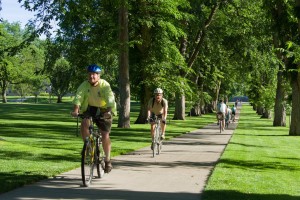Team lands NIH funds to examine tuberculosis and metabolism
Researchers examine factors that make people susceptible to TB and to discover new treatment strategies.
Researchers examine factors that make people susceptible to TB and to discover new treatment strategies.
The CSU Energy Insitute is partnering with a public media group to host SPARK! on April 15.
Researchers at Colorado State University are helping Alaska’s Joint Base Elmendorf-Richardson turn a problem into a positive.
The Tropical Meterology Project team is calling for seven named storms to form.
After three seasons growing in the challenging conditions of the Rocky Mountains, 10 perennial plants have been named "Top Performers" by researchers at Colorado State University.
Seven Teams and three Fellows receive support to advance sustainability research and cross-campus collaboration.
The foundation awards scholarships to students pursuing careers in science, mathematics and engineering.
Colorado State University is one of only four institutions in the country chosen by the U.S. Department of Agriculture to host a new center focused on nutrition education and obesity prevention.
New research by CSU, the Wildlife Conservation Society and others shows that residential development research is lacking when it comes to achieving key sustainability objectives.
Two grants awarded from CDOT will be implemented to improve Pitkin low-stress bicycle network as well as adding secured bicycle parking at transit centers. Colorado State has a long-term commitment to creating transportation options for faculty, staff, employees, students and visitors to campus. “These partnerships will bring projects that will help thousands of students and employees at CSU make the decision to travel to the university without their personal vehicle. We are excited about the impact these grants will bring to our community for years to come,” said Aaron Fodge, manager of Alternative Transportation at CSU.
Improving cross-city and campus bike routes, additional signage
The Pitkin Low Stress Bicycle Route is an east-west connection across the city for bicyclists, passing directly through the center of the CSU campus.
The City of Fort Collins, collaborating with CSU, will lead the effort to create a cross-city bicycle route, add critical improvements to the route through campus, as well as create a bike signal crossing at Shields and intersection improvements at College.
This route currently serves 1,200 CSU employees and more than 5,000 students who live within a half mile of this corridor. When completed, cyclists can travel more safely east-west to and through campus.
Bicycle parking structures at transit facilities
A partnership with Boulder County will construct long-term bicycle parking structures at transit facilities across the transportation corridor, connecting Longmont, Boulder and Fort Collins to improve connections between bicycling and transit.
Secure bicycle parking facilities will be placed at the University Station of Mason corridor to allow transit riders leave their bike at the stop and then complete the rest of their journey via MAX.
“With two bike parking structures in Fort Collins and two more in Boulder, commuters will have the necessary infrastructure in place to rely fully on alternative transportation, which will ultimately increase bicycling activity by allowing more people to get to their bus stop via bike,” Fodge said.
“These partnerships will bring projects that will help thousands of students and employees at CSU make the decision to travel to the university without their personal vehicle. We are excited about the impact these grants will bring to our community for years to come,” said Aaron Fodge, manager of Alternative Transportation at CSU.
Improving cross-city and campus bike routes, additional signage
The Pitkin Low Stress Bicycle Route is an east-west connection across the city for bicyclists, passing directly through the center of the CSU campus.
The City of Fort Collins, collaborating with CSU, will lead the effort to create a cross-city bicycle route, add critical improvements to the route through campus, as well as create a bike signal crossing at Shields and intersection improvements at College.
This route currently serves 1,200 CSU employees and more than 5,000 students who live within a half mile of this corridor. When completed, cyclists can travel more safely east-west to and through campus.
Bicycle parking structures at transit facilities
A partnership with Boulder County will construct long-term bicycle parking structures at transit facilities across the transportation corridor, connecting Longmont, Boulder and Fort Collins to improve connections between bicycling and transit.
Secure bicycle parking facilities will be placed at the University Station of Mason corridor to allow transit riders leave their bike at the stop and then complete the rest of their journey via MAX.
“With two bike parking structures in Fort Collins and two more in Boulder, commuters will have the necessary infrastructure in place to rely fully on alternative transportation, which will ultimately increase bicycling activity by allowing more people to get to their bus stop via bike,” Fodge said.